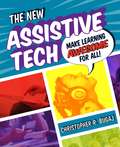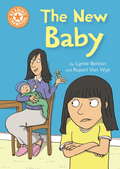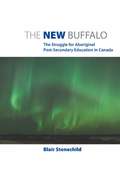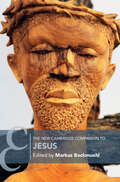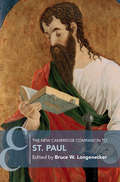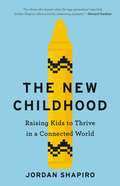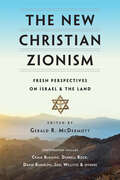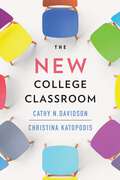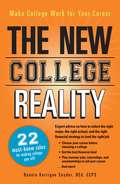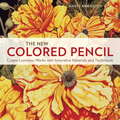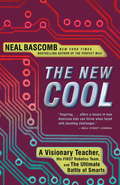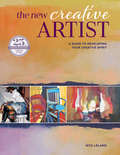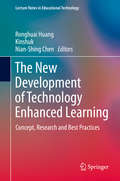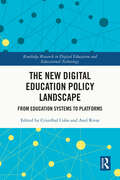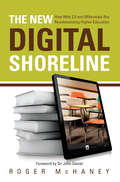- Table View
- List View
The New Assistive Tech: Make Learning Awesome For All!
by Christopher BurgajSchool districts often struggle to develop consistent practices for meeting the assistive needs of special education students. This playful yet professional book will help public school educators select, acquire and implement technology to help all students, but especially those with special needs. The New Assistive Tech is a catalyst for breaking down walls between special education and general education, and will help all educators realize they have tech knowledge (and can build upon that knowledge) that can be used to support students with disabilities. <p><p> This book: details how an educational team can request assistance to determine technology needs; explains how to conduct and document assessments to help an educational team make informed decisions about technology needs; describes a proactive approach to professional development for individuals and for those who train others on the use of technology; assists individuals or teams in creating an action plan for developing a culture of inclusion; and interweaves stories, songs and other exciting features to make learning fun!
The New Authority
by Haim Omer Michal Herbsman Shoshana London SappirHaim Omer builds on his previous work to present a new model of authority for parents, teachers and community workers that is suitable for today's free and pluralistic societies. This new authority contrasts with traditional authority in that it emphasizes self-control and persistence over control of the child, a network of support over a strict hierarchy, taking mutual responsibility for escalations over holding the child solely responsible, patience over threats, non-violent resistance over physical force, and transparency over secrecy. In addition to a thorough discussion of the underlying theory, The New Authority presents a practical program for families, schools and communities. Dr Omer provides specific instructions to combat violence and risky behavior at home and in school, increase parent and teacher interest and support, and implement interventions that increase safety, improve atmosphere and generate community cohesiveness.
The New Authority
by Haim Omer Michal Herbsman Shoshana London SappirHaim Omer builds on his previous work to present a new model of authority for parents, teachers and community workers that is suitable for today's free and pluralistic societies. This new authority contrasts with traditional authority in that it emphasizes self-control and persistence over control of the child, a network of support over a strict hierarchy, taking mutual responsibility for escalations over holding the child solely responsible, patience over threats, non-violent resistance over physical force, and transparency over secrecy. In addition to a thorough discussion of the underlying theory, The New Authority presents a practical program for families, schools and communities. Dr Omer provides specific instructions to combat violence and risky behavior at home and in school, increase parent and teacher interest and support, and implement interventions that increase safety, improve atmosphere and generate community cohesiveness.
The New Baby: Independent Reading Orange 6 (Reading Champion #541)
by Lynne BentonHolly wants a little sister, so when her mum has a baby boy, Holly is disappointed. In this sweet tale of worry, assumptions and big changes, Holly learns that little brothers can be great fun too!Reading Champion offers independent reading books for children to practise and reinforce their developing reading skills.Fantastic, original stories are accompanied by engaging artwork and a reading activity. Each book has been carefully graded so that it can be matched to a child's reading ability, encouraging reading for pleasure.
The New Buffalo: The Struggle for Aboriginal Post-Secondary Education
by Blair StonechildPost-secondary education, often referred to as “the new buffalo,” is a contentious but critically important issue for First Nations and the future of Canadian society. While First Nations maintain that access to and funding for higher education is an Aboriginal and Treaty right, the Canadian government insists that post-secondary education is a social program for which they have limited responsibility.In The New Buffalo, Blair Stonechild traces the history of Aboriginal post-secondary education policy from its earliest beginnings as a government tool for assimilation and cultural suppression to its development as means of Aboriginal self-determination and self-government. With first-hand knowledge and personal experience of the Aboriginal education system, Stonechild goes beyond merely analyzing statistics and policy doctrine to reveal the shocking disparity between Aboriginal and Canadian access to education, the continued dominance of non-Aboriginals over program development, and the ongoing struggle for recognition of First Nations run institutions.
The New Cambridge Companion to Biblical Interpretation (Cambridge Companions to Religion)
by Ian Boxall Bradley C. GregoryThis Cambridge Companion offers an up-to-date and accessible guide to the fast-changing discipline of biblical studies. Written by scholars from diverse backgrounds and religious commitments – many of whom are pioneers in their respective fields – the volume covers a range of contemporary scholarly methods and interpretive frameworks. The volume reflects the diversity and globalized character of biblical interpretation in which neat boundaries between author-focused, text-focused, and reader-focused approaches are blurred. The significant space devoted to the reception of the Bible – in art, literature, liturgy, and religious practice – also blurs the distinction between professional and popular biblical interpretation. The volume provides an ideal introduction to the various ways that scholars are currently interpreting the Bible. It offers both beginning and advanced students an understanding of the state of biblical interpretation, and how to explore each topic in greater depth.
The New Cambridge Companion to Jesus (Cambridge Companions to Religion)
by Markus BockmuehlThe New Cambridge Companion to Jesus serves as the most up to date guide and resource for understanding Jesus' multifaceted legacy, enduring impact over time and space, and relevance in today's world. Integrating textual, historical, theological, and cultural perspectives, the essays, specially commissioned for this volume, also offer a fresh and diverse overview of Jesus' significance in contemporary global contexts. Key features include insights into Jesus' life and teachings, his role in different religious traditions, and his influence on art, music, and global cultures. The volume also addresses contemporary issues of poverty, race, and power dynamics, making it especially relevant for today's readers. The Companion offers a diversity of perspectives from which to approach the unique identity and importance of Jesus beyond the 2020s, whether in relation to Christianity's cultural and existential crises in the Americas, its precipitous decline in Western Europe, or its unprecedented growth and proliferation in Africa and Asia.
The New Cambridge Companion to St Paul (Cambridge Companions to Religion)
by Bruce W. LongeneckerSt Paul was a pivotal and controversial figure in the fledgling Jesus movement of the first century. The New Cambridge Companion to St Paul provides an invaluable entryway into the study of Paul and his letters. Composed of sixteen essays by an international team of scholars, it explores some of the key issues in the current study of his dynamic and demanding theological discourse. The volume first examines Paul's life and the first-century context in which he and his communities lived. Contributors then analyze particular writings by comparing and contrasting at least two selected letters, while thematic essays examine topics of particular importance, including how Paul read scripture, his relation to Judaism and monotheism, why his message may have been attractive to first-century audiences, how his message was elaborated in various ways in the first four centuries, and how his theological discourse might relate to contemporary theological discourse and ideological analysis today.
The New Cambridge History of THE BIBLE
by John RichesThe political, technological, and cultural upheaval of the past two-and-a-half centuries has dramatically altered how we read and understand the Bible. This volume examines the Bible's role in the modern world - beginning with a treatment of its production and distribution that discusses publishers, printers, text critics, and translators and continuing with a presentation of new methods of studying the text that have emerged, including historical, literary, social-scientific, feminist, postcolonial, liberal, and fundamentalist readings. There is a full discussion of the changes in understandings of and approaches to the Bible in various faith communities. The dissemination of the Bible throughout the globe has also produced a host of new interpretations, and this volume provides a comprehensive geographical survey of its reception. In the final chapters, the authors offer a thematic overview of the Bible in relation to literature, art, film, science, and other disciplines. They demonstrate that, in spite of challenges to the Bible's authority in western Europe, it remains highly relevant and influential, not least in the Americas, Africa, and Asia.
The New Cambridge History of The Bible
by Richard Marsden E. Ann MatterThis volume examines the development and use of the Bible from late Antiquity to the Reformation, tracing both its geographical and its intellectual journeys from its homelands throughout the Middle East and Mediterranean and into northern Europe. Richard Marsden and Ann Matter's volume provides a balanced treatment of eastern and western biblical traditions, highlighting processes of transmission and modes of exegesis among Roman and Orthodox Christians, Jews and Muslims and illuminating the role of the Bible in medieval inter-religious dialogue. Translations into Ethiopic, Slavic, Armenian and Georgian vernaculars, as well as Romance and Germanic, are treated in detail, along with the theme of allegorized spirituality and established forms of glossing. The chapters take the study of Bible history beyond the cloisters of medieval monasteries and ecclesiastical schools to consider the influence of biblical texts on vernacular poetry, prose, drama, law and the visual arts of East and West.
The New Cambridge History of The Bible
by James Carleton Paget Joachim SchaperRecent years have witnessed significant discoveries of texts and artefacts relevant to the study of the Old and New Testaments and remarkable shifts in scholarly methods of study. The present volume mirrors the increasing specialization of Old Testament studies, including the Hebrew and Greek Bibles, and reflects rich research activity that has unfolded over the last four decades in Pentateuch theory, Septuagint scholarship, Qumran studies and early Jewish exegesis of biblical texts. The second half of the volume discusses the period running from the New Testament to 600, including chapters on the Coptic, Syriac and Latin bibles, the 'Gnostic' use of the scriptures, pagan engagement with the Bible, the use of the Bible in Christian councils and in popular and non-literary culture. A fascinating in-depth account of the reception of the Bible in the earliest period of its history.
The New Cambridge History of the Bible: The New Cambridge History of the Bible
by Euan CameronThis volume charts the Bible's progress from the end of the Middle Ages to the Enlightenment. During this period, for the first time since antiquity, the Latin Church focused on recovering and re-establishing the text of Scripture in its original languages. It considered the theological challenges of treating Scripture as another ancient text edited with the tools of philology. This crucial period also saw the creation of many definitive translations of the Bible into modern European vernaculars. Although previous translations exist, these early modern translators, often under the influence of the Protestant Reformation, distinguished themselves in their efforts to communicate the nuances of the original texts and to address contemporary doctrinal controversies. In the Renaissance's rich explosion of ideas, Scripture played a ubiquitous role, influencing culture through its presence in philosophy, literature, and the arts. This history examines the Bible's impact in Europe and its increasing prominence around the globe.
The New Childhood: Raising Kids to Thrive in a Connected World
by Jordan ShapiroA provocative look at the new, digital landscape of childhood and how to navigate it.In The New Childhood, Jordan Shapiro provides a hopeful counterpoint to the fearful hand-wringing that has come to define our narrative around children and technology. Drawing on groundbreaking research in economics, psychology, philosophy, and education, The New Childhood shows how technology is guiding humanity toward a bright future in which our children will be able to create new, better models of global citizenship, connection, and community.Shapiro offers concrete, practical advice on how to parent and educate children effectively in a connected world, and provides tools and techniques for using technology to engage with kids and help them learn and grow. He compares this moment in time to other great technological revolutions in humanity's past and presents entertaining micro-histories of cultural fixtures: the sandbox, finger painting, the family dinner, and more. But most importantly, The New Childhood paints a timely, inspiring and positive picture of today's children, recognizing that they are poised to create a progressive, diverse, meaningful, and hyper-connected world that today's adults can only barely imagine.
The New Christian Zionism: Fresh Perspectives on Israel and the Land
by Gerald R. McDermottThe New Christian Zionism
The New College Classroom
by Cathy N. Davidson Christina KatopodisWhat the latest science of learning tells us about inspiring, effective, and inclusive teaching at the college level.College instruction is stuck in the past. If a time traveler from a century ago arrived on today’s campuses, they would recognize only too well the listlessness of the lecture hall and the awkward silence of the seminar room. Yet we know how to do better. Cathy N. Davidson and Christina Katopodis, two of the world’s foremost innovators in higher education, turn to the latest research and methods to show how teachers at every kind of institution can help students become independent, creative, and active learners.The New College Classroom helps instructors in all disciplines create an environment that is truly conducive to learning. Davidson and Katopodis translate cutting-edge research in learning science and pedagogy into ready-to-use strategies to incorporate into any course. These empirically driven, classroom-tested techniques of active learning—from the participatory syllabus and ungrading to grab-and-go activities for every day of the term—have achieved impressive results at community colleges and research universities, on campus, online, and in hybrid settings.Extensive evidence shows that active-learning tools are more effective than conventional methods of instruction. Davidson and Katopodis explain how and why their approach works and provide detailed case studies of educators successfully applying active-learning techniques in their courses every day, ensuring that their students are better prepared for the world after college.
The New College Reality
by Bonnie Kerrigan SnyderThis guide arms families with the knowledge they need to turn a college education into a tool for finding a career that can pay off. Snyder's 22 revolutionary rules show how to integrate job planning and education, along with financial responsibility.
The New College Reality
by Bonnie Kerrigan SnyderCollege is the doorway to a golden future, right? But if you're not careful, it's also a path to a mountain of debt. Worst-case scenario: You struggle for years to pay for an education that you can't turn into a paying job. But it doesn't have to be that way. In The New College Reality, Dr. Bonnie Snyder tells you how the system works and how to make college pay off. Forget conventional wisdom and let her revolutionary rules show you how to integrate job planning and education with financial responsibility: Make sure your degree relates to existing or emerging jobs Resumes, personal brands, and college contacts lead to jobs Shelter your assets from the financial aid formula Limit your total borrowing to your expected first-year salary Always be ready to create your own job Don't squander money on a useless, self-indulgent degree. Instead, squeeze maximum career value out of every semester of college while scrimping on costs. The result will be a great career that really uses your education.
The New College Reality: Make College Work For Your Career
by Bonnie Kerrigan SnyderCollege is the doorway to a golden future, right? But if you're not careful, it's also a path to a mountain of debt. Worst-case scenario: You struggle for years to pay for an education that you can't turn into a paying job.But it doesn't have to be that way. In The New College Reality, Dr. Bonnie Snyder tells you how the system works and how to make college pay off. Forget conventional wisdom and let her revolutionary rules show you how to integrate job planning and education with financial responsibility:Make sure your degree relates to existing or emerging jobsResumes, personal brands, and college contacts lead to jobsShelter your assets from the financial aid formulaLimit your total borrowing to your expected first-year salaryAlways be ready to create your own job Don't squander money on a useless, self-indulgent degree. Instead, squeeze maximum career value out of every semester of college while scrimping on costs. The result will be a great career that really uses your education.
The New Colored Pencil
by Kristy Ann KutchLearn to draw and paint using colored pencils in The New Colored Pencil: a how-to guide for creating vibrant, textured, and easy art illustrations by best-selling author and teacher Kristy KutchMaster the Latest Breakthroughs in Colored Pencil ArtIf you want to create colorful, radiant works of art, colored pencil and related color media (pastels, watercolor pencils, and so on) provide you with limitless options for adding vibrancy to your creations. In The New Colored Pencil, artist and instructor Kristy Ann Kutch guides you through the latest developments in color drawing media with examples of and recommendations for the newest pencil brands, drawing surfaces, and groundbreaking techniques (including using the Grid Method, grating pigments, blending with heat, and more). Supported by step-by-step demonstrations and showcasing inspiring art from some of today's best colored pencil artists, The New Colored Pencil shows you how to use color theory to your advantage, combine color media, create and enhance textures, and experiment with surfaces to create interesting effects. Whether you use traditional, wax-based, or watercolor colored pencils, The New Colored Pencil will take your art to the next level.
The New Cool: A Visionary Teacher, His First Robotics Team, and the Ultimate Battle of Smarts
by Neal BascombThat Monday afternoon, in high-school gyms across America, kids were battling for the only glory American culture seems to want to dispense to the young these days: sports glory. But at Dos Pueblos High School in Goleta, California, in a gear-cluttered classroom, a different type of "cool" was brewing. A physics teacher with a dream - the first public high-school teacher ever to win a MacArthur Genius Award -- had rounded up a band of high-I.Q. students who wanted to put their technical know-how to work. If you asked these brainiacs what the stakes were that first week of their project, they'd have told you it was all about winning a robotics competition - building the ultimate robot and prevailing in a machine-to-machine contest in front of 25,000 screaming fans at Atlanta's Georgia Dome. But for their mentor, Amir Abo-Shaeer, much more hung in the balance. The fact was, Amir had in mind a different vision for education, one based not on rote learning -- on absorbing facts and figures -- but on active creation. In his mind's eye, he saw an even more robust academy within Dos Pueblos that would make science, technology, engineering, and math (STEM) cool again, and he knew he was poised on the edge of making that dream a reality. All he needed to get the necessary funding was one flashy win - a triumph that would firmly put his Engineering Academy at Dos Pueblos on the map. He imagined that one day there would be a nation filled with such academies, and a new popular veneration for STEM - a "new cool" - that would return America to its former innovative glory. It was a dream shared by Dean Kamen, a modern-day inventing wizard - often-called "the Edison of his time" - who'd concocted the very same FIRST Robotics Competition that had lured the kids at Dos Pueblos. Kamen had created FIRST (For Inspiration and Recognition of Science and Technology) nearly twenty years prior. And now, with a participant alumni base approaching a million strong, he felt that awareness was about to hit critical mass. But before the Dos Pueblos D'Penguineers could do their part in bringing a new cool to America, they'd have to vanquish an intimidating lineup of "super-teams"- high-school technology goliaths that hailed from engineering hot spots such as Silicon Valley, Massachusetts' Route 128 technology corridor, and Michigan's auto-design belt. Some of these teams were so good that winning wasn't just hoped for every year, it was expected. In The New Cool, Neal Bascomb manages to make even those who know little about - or are vaguely suspicious of - technology care passionately about a team of kids questing after a different kind of glory. In these kids' heartaches and headaches - and yes, high-five triumphs -- we glimpse the path not just to a new way of educating our youth but of honoring the crucial skills a society needs to prosper. A new cool.From the Hardcover edition.
The New Creative Artist: A Guide to Developing Your Creative Spirit
by Nita LelandOvercome your artist's block and explore what drives you artistically! Artist and teacher Nita Leland shows how to be creative in daily life to develop and strengthen your natural curiosity, flexibility, independence and playfulness--all with the end-goal of creating more inspired, unique personal artwork. Enjoy a variety of fun activities designed to exercise your creative muscle, including how to make an autobiographical collage, creating an idea jar for when you need a random jumpstart, and how to make "dull" subjects more interesting. Learn to push your creative boundaries by trying new methods in dozens of types of media including paper crafts, Japanese brush painting, creative quilting, inventive photography, grown-up finger painting, monotype and more.110+ activities that inspire creativityArtists of all skill levels and mediums can tap into their creativity through exciting techniques and exercisesInspirational tips and advice for taking creative risks to make more meaningful artistic statementsInspiring art from 100 contributing fine artists and crafters in every medium coaching readers to creative success
The New Development of Technology Enhanced Learning
by Kinshuk Ronghuai Huang Nian-Shing ChenThe book addresses the main issues concerned with the new development of learning processes, innovative pedagogical changes, the effects of new technologies on education, future learning content, which aims to gather the newest concepts, research and best practices on the frontiers of technology enhanced learning from the aspects of learning, pedagogies and technologies in learning in order to draw a picture of technology enhanced learning in the near future. Some issues like "e-learning . . . m-learning . . . u-learning - innovative approaches," "the Framework and Method for Understanding the New Generation Students," "Context-aware Mobile Role Playing Game for Learning," " Pedagogical issues in content creation and use: IT literacy through Spoken Tutorials," "Supporting collaborative knowledge construction and discourse in the classroom," "Digital Systems for Hierarchical Open Access to Education," " Using Annotated Patient Records to Teach Clinical Reasoning to Undergraduate Students of Medicine," " Utilizing Cognitive Skills Ontology for Designing Personalized Learning Environments" and "Using Interactive Mobile Technologies to Develop Operating Room Technologies Competency" are discussed in separate chapters.
The New Digital Education Policy Landscape: From Education Systems to Platforms (Routledge Research in Digital Education and Educational Technology)
by Axel Rivas Cristóbal CoboThis book provides a scholarly investigation of the new era we have entered, in which platforms can replace or profoundly modify educational systems, and questions the role of educational policy in this new stage of platform-based digital technology. The contributors explore important questions around who controls these transformations, what form they are taking, what the balance between national education policies and Big Tech education solutions should be, as well as whether there should be a public platform in every education system that digitally expands learning, and what evidence there is that learning will be more efficient using these platforms. The first part provides a selection of empirical studies on the new digital educational policy, and an analysis of the real opportunities and concerns that governments face in this regard, while the second offers reflections on the processes of platformization and the role of the State in this new digital world. Uniquely examining the temporal evolution of these changes and taking a theoretical, political, and epistemological approach, it crucially opens pathways for dialogical, and diverse critical thinking about profound problems and possibilities. Gathering purposeful thinking that creates space for design solutions and rethinking educational systems considering these new technological artifacts, it will appeal to researchers and specialists in the fields of educational technology and educational policy.
The New Digital Shoreline: How Web 2.0 and Millennials Are Revolutionizing Higher Education
by Roger McHaneyTwo seismic forces beyond our control – the advent of Web 2.0 and the inexorable influx of tech-savvy Millennials on campus – are shaping what Roger McHaney calls “The New Digital Shoreline” of higher education. Failure to chart its contours, and adapt, poses a major threat to higher education as we know it.These forces demand that we as educators reconsider the learning theories, pedagogies, and practices on which we have depended, and modify our interactions with students and peers—all without sacrificing good teaching, or lowering standards, to improve student outcomes. Achieving these goals requires understanding how the indigenous population of this new shoreline is different. These students aren’t necessarily smarter or technologically superior, but they do have different expectations. Their approaches to learning are shaped by social networking and other forms of convenient, computer-enabled and mobile communication devices; by instant access to an over-abundance of information; by technologies that have conferred the ability to personalize and customize their world to a degree never seen before; and by time-shifting and time-slicing.As well as understanding students’ assumptions and expectations, we have no option but to familiarize ourselves with the characteristics and applications of Web 2.0—essentially a new mind set about how to use Internet technologies around the concepts of social computing, social media, content sharing, filtering, and user experience.Roger McHaney not only deftly analyzes how Web 2.0 is shaping the attitudes and motivations of today’s students, but guides us through the topography of existing and emerging digital media, environments, applications, platforms and devices – not least the impact of e-readers and tablets on the future of the textbook – and the potential they have for disrupting teacher-student relationships; and, if appropriately used, for engaging students in their learning.This book argues for nothing less than a reinvention of higher education to meet these new realities. Just adding technology to our teaching practices will not suffice. McHaney calls for a complete rethinking of our practice of teaching to meet the needs of this emerging world and envisioning ourselves as connected, co-learners with our students.
The New Early Years Professional: Dilemmas and Debates
by Angela D. NurseCelebrating the spirit and need for increased multi-disciplinary working and co-operation in the care and education of children, this book addresses the emergence of a new type of early years professional. It will support the reader in understanding the background and context to the current situation of change and excitement as well as help them reflect on the challenges and possibilities of future Early Years and interagency working. It covers key issues such as: families, children and culture health and well-being safeguarding children leadership and management. Adopting an analytical and reflective style appropriate for degree-level study, this book is a core reader for all Early Childhood Studies and Early Years courses.
